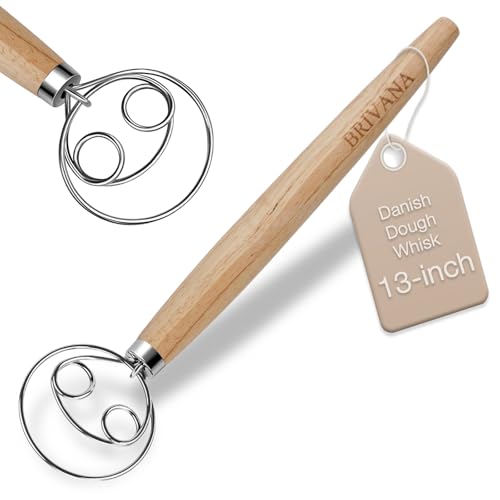Danish vs. Seamless: Which Whisk Reigns Supreme?
***As an Amazon Associate, we earn from qualifying purchases.
A Comprehensive Comparison of the Two Favorites in Sourdough Baking
Whisks play a pivotal role in the artistry of baking, particularly when it comes to sourdough preparation. Among the ample choices available, the Danish whisk and the seamless whisk have emerged as prime contenders, each boasting its own advantages and quirks. To help you decide which whisk is best suited to your sourdough journey, we present an extensive comparison of these tools.
Danish Whisk: A Traditional Favorite
Cons of the Danish Whisk
1. Risk of Disconnection: One of the major drawbacks of the Danish whisk is that the stainless steel head can detach from the wooden handle. This tends to happen at the most inconvenient times—imagine being elbow-deep in sticky sourdough only for your whisk to come apart. It's a frustrating experience that can make you question its reliability.
2. Cleaning Challenges: Despite claims of being easy to clean, the Danish whisk can pose difficulties, especially for individuals with restricted hand or finger movement. Dough tends to wedge itself into crevices, turning cleanup into a laborious affair.
3. Length Concerns: The typical 13-inch handle of the Danish whisk might be unwieldy for smaller individuals. At 5'5", for instance, managing the whisk can feel like wrestling with a wild creature, leaving you juggling the bowl, the dough, and the whisk in a chaotic dance.
Pros of the Danish Whisk
1. High-Quality Materials: Danish whisks are typically crafted with a stainless steel head and a wooden handle. The handle is often made from high-grade beechwood, oak, or pear, offering both durability and an elegant appearance.
2. Cost-Effective: Purchasing a Danish whisk doesn't have to break the bank. A pair of 13-inch whisks can be found on Amazon for under $10, https://amzn.to/4mDUsZD, making them a budget-friendly option for home bakers.
3. Ergonomics for Tough Tasks: The unique design of the Danish whisk allows it to penetrate deeply into thick sourdough and other heavy batters. Unlike regular whisks, its ergonomic advantage shines when tackling dense mixtures, reducing the strain on your wrists and forearms.
Seamless Whisk: The Modern Marvel
Pros of the Seamless Whisk
1. Sturdy One-Piece Design: The seamless whisk is crafted from a single, solid piece of stainless steel. This eliminates the concern of parts falling apart mid-use, ensuring consistent performance and durability.
2. Affordable Price Point: Starting at less than $5 each on Amazon, https://amzn.to/45j432s, the seamless whisk offers excellent value for money, competing closely with the Danish whisk in terms of affordability.
3. Manageable Length: Averaging around 9-10 inches, the seamless whisk is easier to handle, particularly for individuals with limited mobility or smaller hands. Its compact size makes it a user-friendly choice, especially if you struggle with conditions like arthritis.
4. Effortless Cleanup: The seamless whisk excels in simplicity when it comes to maintenance. A quick rinse under hot water or a toss in the dishwasher is all it takes to keep it spotless—a feature that is especially appreciated by busy bakers.
5. Versatile Performance: Beyond whisking, the seamless whisk is capable of handling stretch-and-pull techniques in sourdough preparation. Its robust design makes it a multipurpose tool, saving both time and energy.
Cons of the Seamless Whisk
1. Limited Availability: The only notable drawback of the seamless whisk is the scarcity of its presence in your kitchen. Many users find themselves wishing they had more than one at their disposal, given its utility and efficiency.
Which Whisk Wins?
Choosing between the Danish whisk and the seamless whisk ultimately depends on your specific needs and priorities. If you're drawn to traditional craftsmanship and need a budget-friendly option, the Danish whisk may be an attractive choice. However, if durability, convenience, and versatility are at the top of your list, the seamless whisk emerges as the clear winner.
Conclusion
Both whisks have their merits, and the decision comes down to your personal preference and baking habits. For those embarking on the sourdough journey, the seamless whisk offers unmatched reliability and ease of use, while the Danish whisk provides affordability and a touch of classic charm. Whatever whisk you choose, you'll be well-equipped to tackle the challenges of crafting perfect sourdough creations. Happy baking!



